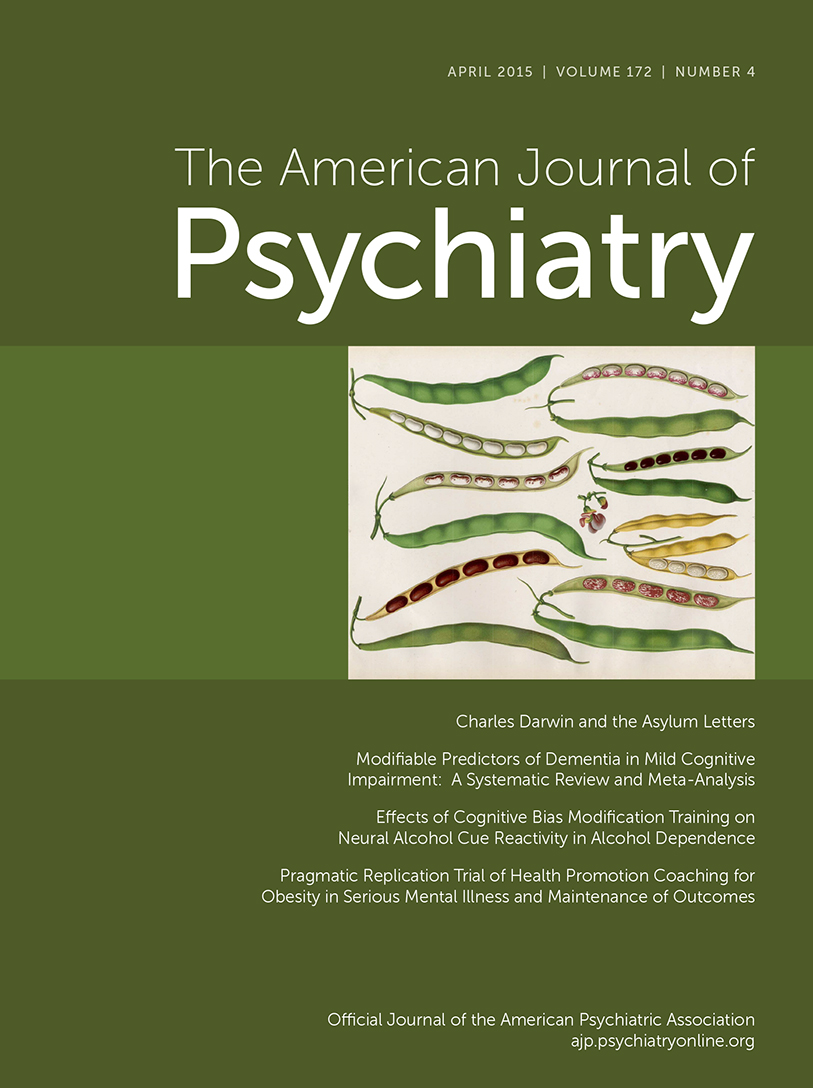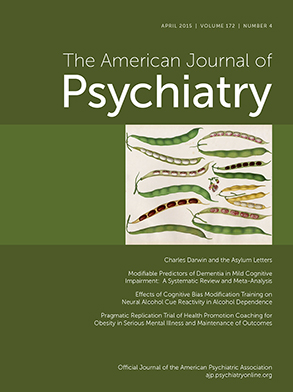Alcohol use disorders are common and devastating diseases with a strong genetic component. Prevalence in the United States in adult men is about 12% (
1). Besides the social and economic consequences of uncontrolled alcohol drinking, these disorders account for one in 10 deaths annually through accidents and secondary medical problems such as cirrhosis (
2). Despite the importance of this category of disorders, less than a third of patients with alcohol use disorders receive any treatment, and fewer still receive evidence-based treatment. Early in the course of the disease, when treatment is most effective, symptoms are often ignored by medical practitioners. The typical patient is only diagnosed late in the course of this progressive disease, when the symptoms become severe.
Eventually a crisis develops that results in medical attention. If insurance coverage is available, the patient may be admitted to a residential program, and the patient receives medication to ease the symptoms of alcohol withdrawal.
Even though Food and Drug Administration-approved medications with proven efficacy in reducing relapse are available, fewer than 10% of patients are treated with such medications (
3). The typical residential program is built around “milieu” therapy and self-help groups. These treatment approaches lack efficacy, as demonstrated by controlled outcome studies. Some evidence-based psychotherapies, such as cognitive-behavioral therapy and motivational interviewing, are available (
4), but none of them focus on the brain changes that produce the uncontrolled drinking. Instead, the typical treatment program stresses counseling, support, and group therapy. Patients are made comfortable with a healthy diet, educational lectures, and perhaps massage therapy and other spa-like features. Patients are advised to avoid people, places, or things that remind them of alcohol. By the end of 30 days, the patient may feel relatively well and optimistic, but the neuroplasticity, the changes in the brain that have become ingrained, have not been addressed. Thus, it is not surprising that repeated relapses to uncontrolled drinking are common.
Focus on Brain Changes
The treatment described by Wiers et al. in this issue (
5) is different because the focus is on the core problem in addiction. There has been consistent evidence published over the past two decades showing that as addiction develops, brain circuits are changed. All of the drugs that lead to addictive behavior act directly on the reward system, which is the system involved in establishing new and long-lasting memories (
6). This is true of alcohol as well as of other drugs of abuse, although the pharmacological mechanisms differ. The Wiers et al. article represents a radical step in that the authors report a new therapeutic procedure that fundamentally changes the brain’s reactivity to alcohol cues. Their procedure is relatively simple and straightforward. By retraining the approach bias in abstinent alcohol-dependent patients using a joystick-controlled approach-avoidance task, they have produced a reduction in brain activation and therefore of craving in response to alcohol cues. The effects of the training procedure were demonstrated in a controlled comparison to a sham-treated group of alcohol-dependent patients and were measured by brain activation using functional MRI (fMRI).
The significance of this finding and others utilizing a similar procedure with the same results (
7) is that they show that treatment of alcohol use disorders should include an evidence-based technique to address the underlying brain changes involved in the disease’s major symptoms. Retraining the brain can be incorporated into the existing residential and outpatient approaches to produce added benefits. The simplicity of the procedure lends itself to being combined with anticraving medication in both residential and outpatient programs. Food and Drug Administration-approved relapse prevention medications, although rarely prescribed, do have proven efficacy (
3). One reason for their lack of use is the lack of a large average effect size. In another fMRI study (
8), naltrexone was also shown to reduce alcohol cue-induced brain activation and craving. Therefore, combining medication and behavioral bias retraining could have an additive effect, producing a larger decrease in brain response to alcohol cues, thus further reducing relapse.
Comorbidity Studies
Alcohol use disorders commonly occur in combination with other mental disorders; two of the most common are depression and anxiety disorders (
2). The Wiers et al. bias retraining method conveniently lends itself to combination with existing methods to treat these dual disorders. Depression with alcohol use disorders has been shown in a controlled clinical trial to respond to a combination of an antidepressant (sertraline) and an anticraving medication (naltrexone) (
9). Here again, bias retraining could conveniently be added to the sertraline and naltrexone combination for enhanced efficacy in reducing drinking.
In the case of posttraumatic stress disorder (PTSD), the efficacy of behavioral therapy can be thwarted by a return to heavy drinking. Recently it was reported that adding naltrexone to exposure therapy reduced drinking, a common cause of treatment failure in PTSD (
10). The addition of bias retraining to the therapy could further reduce reactivity to alcohol cues and thus improve retention in the anxiety-reduction behavioral therapy. Again, the convenience and brevity of bias retraining makes it ideally suited to combination with any therapy where there is risk of relapse to alcohol drinking.
In summary, the report by Wiers et al. provides the possibility for all programs treating alcohol use disorders to finally address the fundamental problem for alcohol-dependent individuals: the high rate of relapse to heavy drinking. Brain reactivity to alcohol cues is a conditioned response, trained in the brain as the addiction develops. This reactivity is seen not only in those addicted to alcohol, but also in other addicts, such as tobacco smokers, heroin addicts, and cocaine addicts. These brain reactions are automatic, often outside of awareness and long-lasting, but they are virtually ignored in most treatment programs for drug addictions. Patients can understand conditioned responses, and cue responsivity can be used as a measure of progress. We now need randomized clinical trials with appropriate control groups to determine conclusively whether focusing on the brain does in fact result in improved overall outcome.

